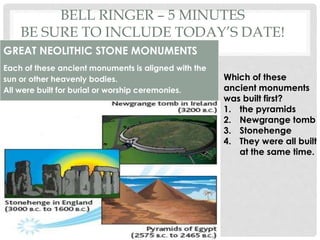
Ancient Monuments Aligned with Heavenly Bodies
- 1. BELL RINGER – 5 MINUTES BE SURE TO INCLUDE TODAY’S DATE! GREAT NEOLITHIC STONE MONUMENTS Each of these ancient monuments is aligned with the sun or other heavenly bodies. All were built for burial or worship ceremonies. Which of these ancient monuments was built first? 1. the pyramids 2. Newgrange tomb 3. Stonehenge 4. They were all built at the same time.
- 2. C H A P T E R 1 – S E C T I O N 1 ( P A G E S 8 - 1 5 ) EARLY HUMANS
- 3. BY THE END OF THE LESSON, YOU WILL LEARN: • Recognize the importance of fire, weapons, and tools to early cultures and agriculture. • List ancient weapons and tools. • Understand the role of the environment in terms of influencing the development of weapons, and tools. • Explain the role of agriculture in early settled communities. • Understand the place of historical events in the context of past, present and future. • Identify the characteristics of hunter-gatherer communities in various continental regions in Africa versus the Americas. • Recognize the types of early communities (i.e., nomadic, fishing, farming). • Identify major technological advances (i.e., tools, wheel, irrigation). • Recognize major historical time periods (i.e., Early Civilizations . • Recognize the basic components of culture (i.e., language, common values, traditions, government, art, literature, lifestyles). • Identify disadvantages and advantages of nomadic and early farming lifestyles (i.e., shelter, food supply, and, domestication of plants and animals). • Recognize the steps that give rise to complex governmental organizations (i.e., nomadic, farming, village, city, city-states, and states).
- 4. Locating Places • Jericho (JEHR•ih•KOH) • Çatal Hüyük (chah•TAHL hoo•YOOK) Building Your Vocabulary • historian (hih•STOHR•ee•uhn) • archaeologist (AHR•kee•AH•luh•jihst) • artifact (AHR•tih•FAKT) • fossil (FAH•suhl) • anthropologist (AN•thruh•PAH•luh•jihst) • nomad (NOH•MAD) • technology (tehk•NAH•luh•jee) • domesticate (duh•MEHS•tih•KAYT) • specialization (SPEH•shuh•luh•ZAY•shuhn)
- 5. VIDEO
- 6. JOBS IN SOCIAL STUDIES • History is the story of humans in the past, and historians are the people who study and write about humans of the past. • Archaeologists hunt for evidence buried in the ground. • Anthropologists study how humans developed and related to each other.
- 7. • The early period of human history is called the Stone Age. The earliest part of the Stone Age is called the Paleolithic period.
- 8. • Paleolithic people were nomads, traveling from place to place to hunt and search for food.
- 9. • Paleolithic women cared for children and gathered berries, nuts, and grains. Paleolithic men hunted animals using clubs, spears, traps, and bows and arrows.
- 10. Paleolithic people adapted to their environment. Those in warm climates wore little clothing and had little need for shelter. Those in cold climates used caves for shelter. Over time, they learned to create shelters from animal hides and wooden poles.
- 11. • Paleolithic people discovered fire, which kept them warm, lit the darkness, and cooked food.
- 12. ICE AGE • Long periods of extreme cold are called the Ice Ages. During the Ice Ages, thick sheets of ice covered parts of Europe, Asia, and North America. • Nomadic lifestyle • following food supplies • avoiding temperature extremes
- 13. LANGUAGE • Paleolithic people developed spoken language and expressed themselves through art, which may have had religious meaning.
- 14. TOOLS • During this time, humans created tools such as spears and hand axes using stone called flint.
- 15. • How did spoken language help the Paleolithic people? • (Language made it easier for people to work together and pass on knowledge.)
- 16. NEOLITHIC PEOPLE • In the beginning of the Neolithic Age, people began to domesticate, or tame, animals. Domesticated animals carried goods and provided meat, milk, and wool.
- 17. CROPS LED TO VILLAGES • People in different parts of the world began growing crops about the same time. Historians call this change the farming revolution. • Because farmers needed to stay close to their fields, they built permanent homes in villages.
- 18. JERICHO & ÇATAL HÜYÜK One of the oldest villages is Jericho in present-day Israel and Jordan. • Another Neolithic village is • Çatal Hüyük in present-day • Turkey.
- 19. NEOLITHIC VILLAGES • Permanent villages provided people with security and steady food. The surplus food led to a larger population.
- 20. JOBS OF VILLAGERS • Not all people in a village were farmers. Some made pottery, mats, and cloth. They traded these goods for things they did not have.
- 21. NEOLITHIC TECHNOLOGY • People continued to create new technology. They created better farming tools and began working with metal, copper, and tin. They also began working with bronze.
- 22. ERAS OF EARLY HUMAN HISTORY • Paleolithic Era (1 million-40,000 yrs. ago) • simple stone tools • simple shelters • cave paintings • Neolithic (10,000 yrs. ago) • farming • innovation • complex societies • defined polytheistic ideologies
- 24. • Why was farming important to the Neolithic people? (Farming allowed people to settle in one place, and it provided a steady food supply.) •
- 25. ASSIGNMENT • You will complete a Venn Diagram on Paleolithic and Neolithic people. • You will correctly place the following characteristics in the correct place on your diagram. • lived in small groups of nomads • created wall paintings • underwent the farming revolution • lived in villages • made farming tools • practiced specialization of jobs • made tools out of copper and bronze • built shelters • hunted and fished • gathered plants and fruits • made stone tools and weapons • farmed, raised animals, and traded • discovered how to use fire • started to speak a language • created cave paintings